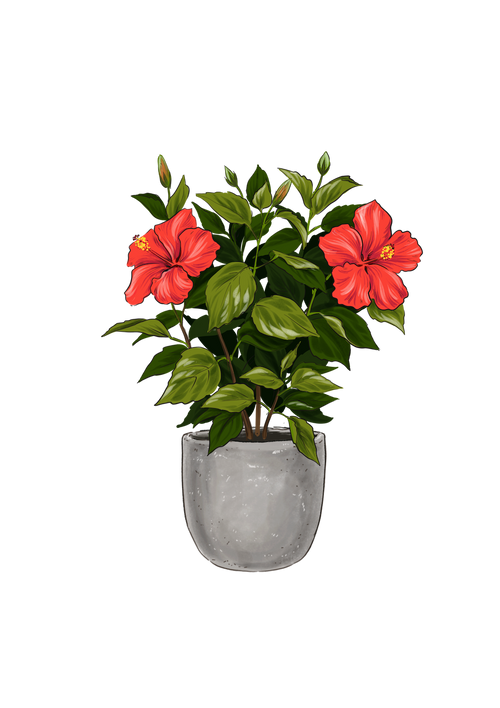Hibiscus Care Guide

-
Light : High
Outdoors:This plant loves the sun and can be put on a patio outdoors in full sun to part shade where the temperatures don't dip below 50°F. Indoors: The Hibiscus shrub can be overwintered indoors in a brightly lit location. These plants may drop their buds in protest when positions are changed.
-
Water : Medium
Use unsoftened, filtered, bottled, or tap water sitting 24 hours to release the chemicals and water enough that the water discharges out of the drainage holes. Once the water is fully drained, replace them into the cache or decorative pot. Replenish the soil moisture when it falls below 5 on the plant meter. Keep them consistently moist during the growing season (but not soggy) and let them dry out to a 3 on the moisture meter in winter months when they are dormant. If yellowing leaves occur, back off on the watering and let the soil dry out a bit more between waterings.
-
Humidity : Medium
Hibiscus needs humidity at a rate of 40-60%. Use a pebble tray, humidifier and group plants together to raise the humidity levels.
-
Temp : 50℉ - 79℉
This tropical plant loves warm climates and moderate humidity.
-
Zone : 9|10|11
This plant will not tolerate frost or temperatures below 60°F if left outside.
-
Fertilizer : Seasonally
Container: When the plant is rootbound or there is dieback on their growth, they are ready to repot (early spring before growth starts), plant in a 2" bigger container in diameter and slightly deeper than the existing planter. Use an indoor container mix that is well-draining. Add soil to the bottom to elevate the root ball. Lift the plant and inspect the root ball. Notice if there are any dead or rotting roots and trim them off with sterile pruners. If the plant is rootbound, cut through the roots to alleviate continued encircling. Ensure the plant is sitting about 1" below the edge of the pot to avoid water spillage. Add more soil and backfill around the sides by tamping down. Do not cover the current level of soil on the plant but add soil up to this level. Water thoroughly, leaving the soil damp but not soggy. Add more soil after watering if the soil settles. Outdoors: Before planting the Hibiscus into the ground, water the plant in the grower pot well. Find a spot in the garden where there are at least 6 hours of direct sunlight each day. Be generous by digging a hole twice the pot's width and 1 inch shorter than the grower pot to raise it above the soil level for good drainage. Use a pitchfork or a sharp object to stab the soil walls to make several indentions for the roots to take hold. Tickle the roots to loosen them if they wrap inside the container. Place the plant in the center of the hole. Fill the hole with water first, so the roots get another good drink. Next, backfill with native soil mixed with compost by one-third to one-half (if the native soil is clay). Add a rooting hormone fertilizer to this backfill mixture. Tamp the soil firmly down around the edges and mound up. Avoid covering the original soil level of the plant that was in the container. Add mulch as needed but not next to the stem or branches of the plant. Water lightly. Continue to observe the soil moisture each day, depending on the temperatures and soil drainage.
-
Repotting :
-
Cleaning : Bi-annually
Prune in early spring and remove up to 1/3 of old wood to keep the plant blooming and dense with new growth.
-
Propagation : Stem Cutting
Take green stem cuttings from the tips of the parent plant. Cut with sterile scissors taking a 3-6 inch cutting. Dip in rooting hormone and place them in moist potting soil. Cover with a clear plastic bag to retain moisture and humidity while they root. Keep the cuttings in bright, indirect light. After four weeks, check the rooting of the baby cutting by pulling gently on the leaf. If they are snug, then roots are forming. Keep them covered until new shoots appear. Remove the clear bag at this point and keep evenly moist and humidity levels high while they mature. Avoid moving locations during propagation.